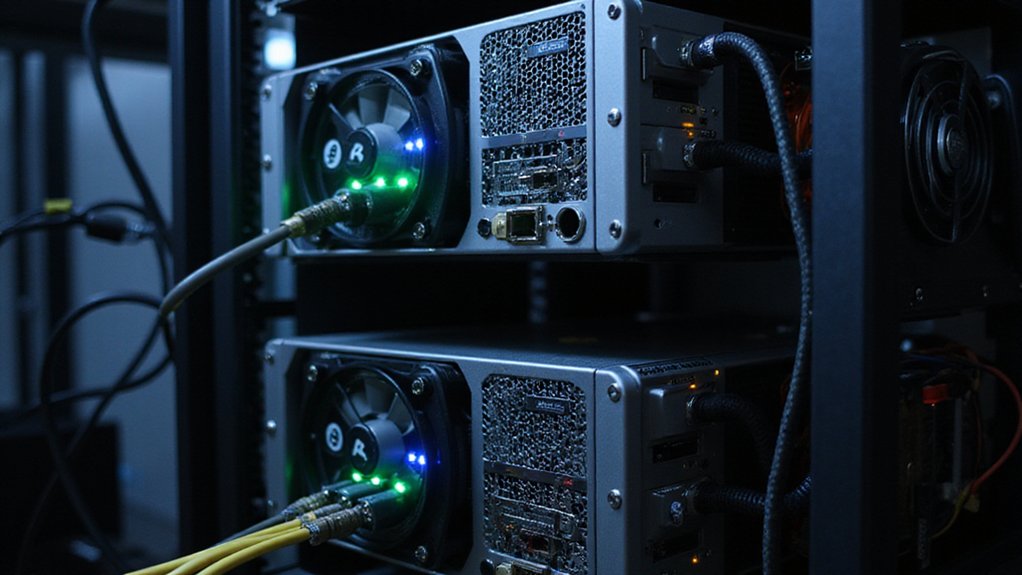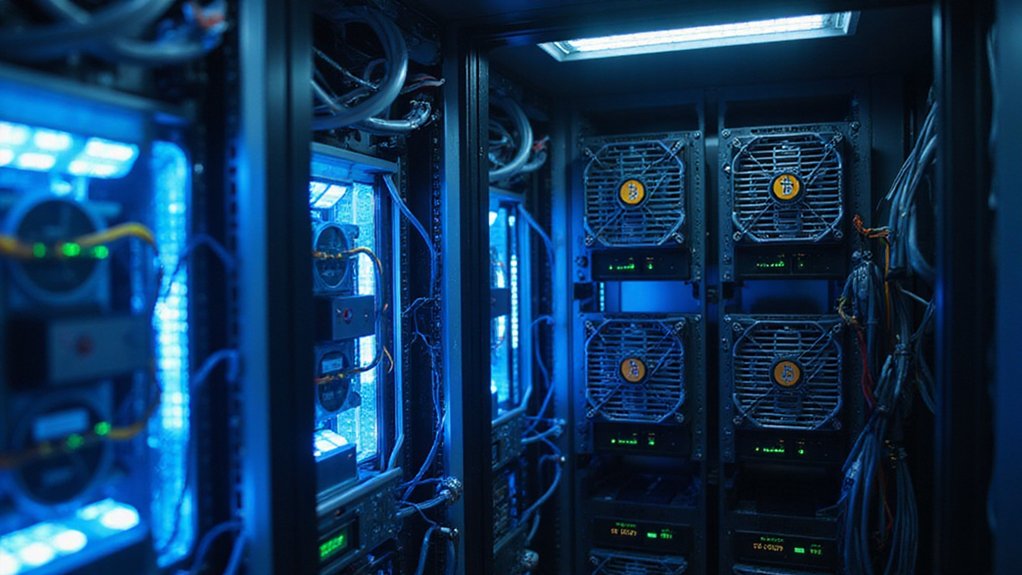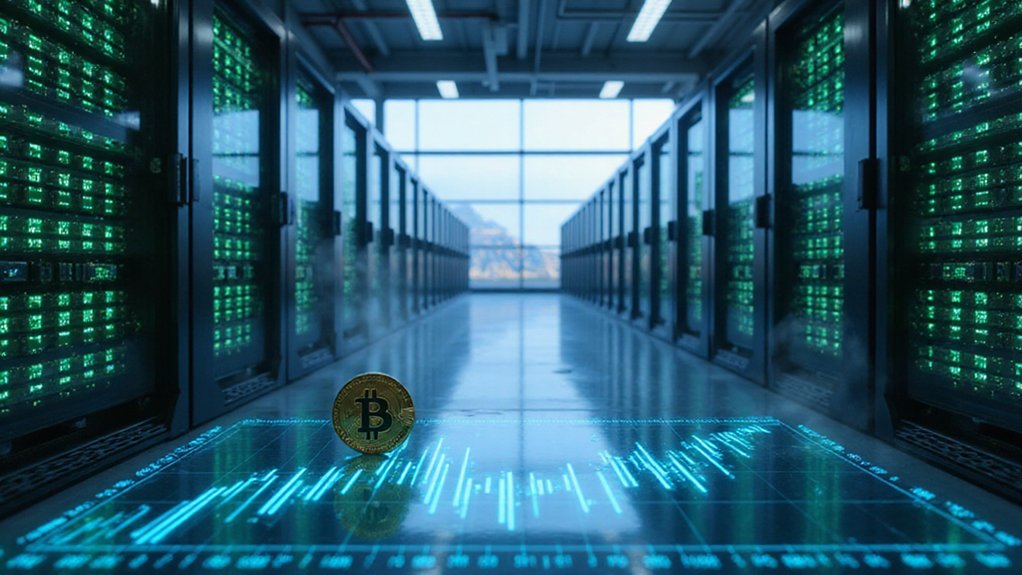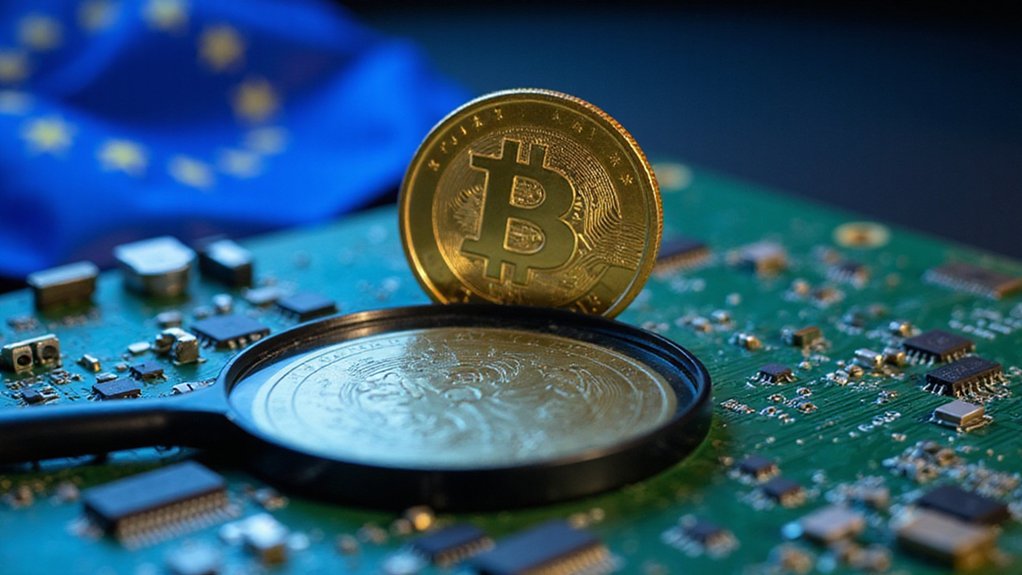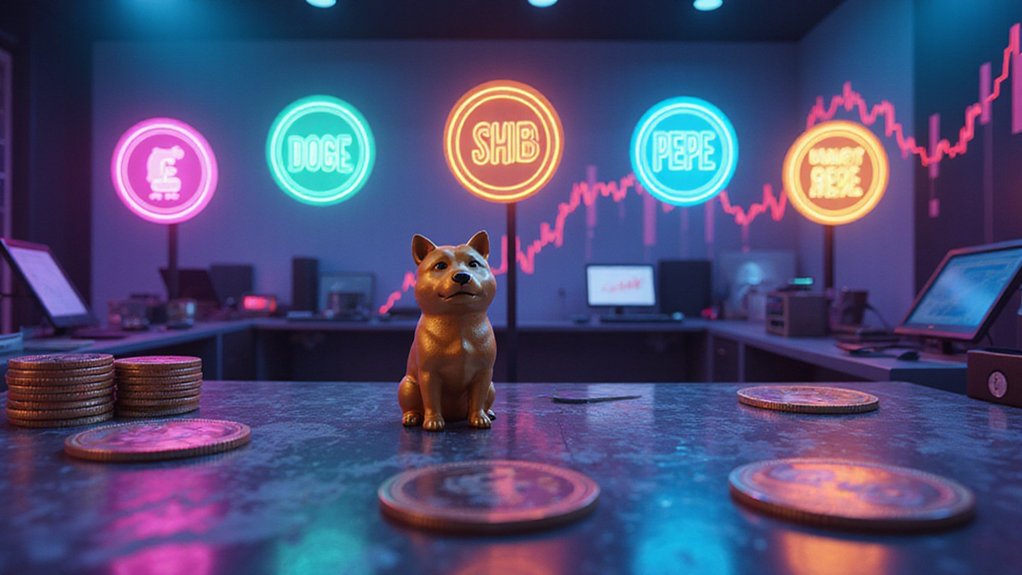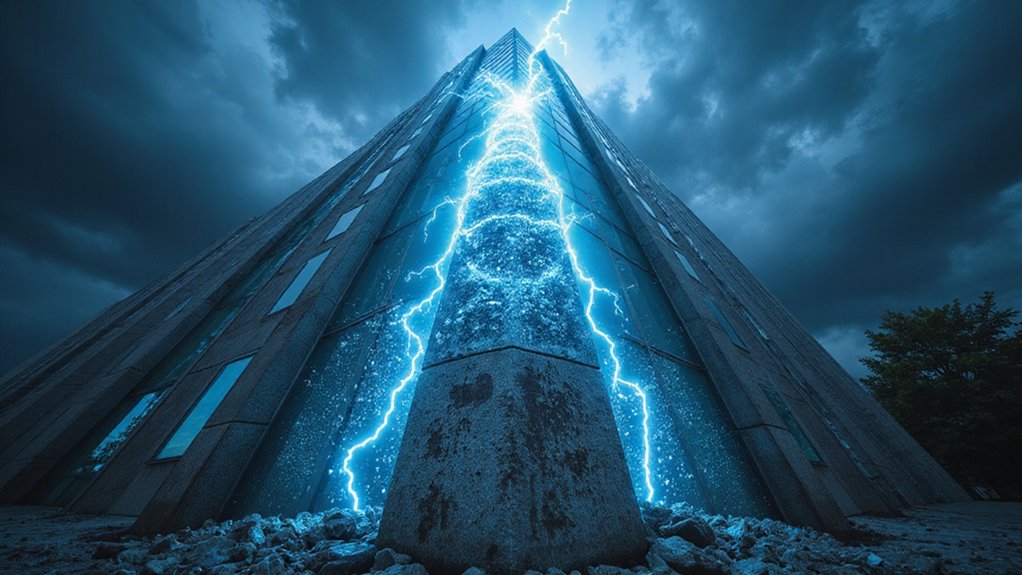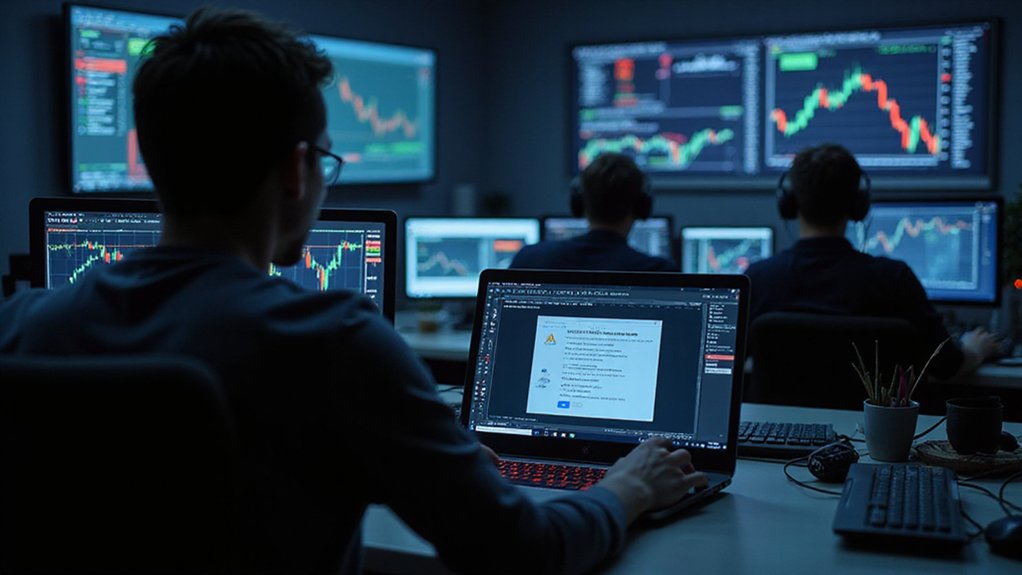Bitcoin mining hardware has evolved from CPU mining to specialized ASIC devices that render general-purpose equipment obsolete. Beginners should focus on key metrics: hashrate (computational power measured in TH/s) and energy efficiency (J/TH). Popular options include Bitmain’s Antminer S21 Pro (234 TH/s) and MicroBT’s Whatsminer M66S (298 TH/s). Profitability hinges on electricity costs, cooling requirements, and depreciation—a calculus that increasingly favors industrial-scale operations. The remainder of this guide unpacks these considerations in painful detail.
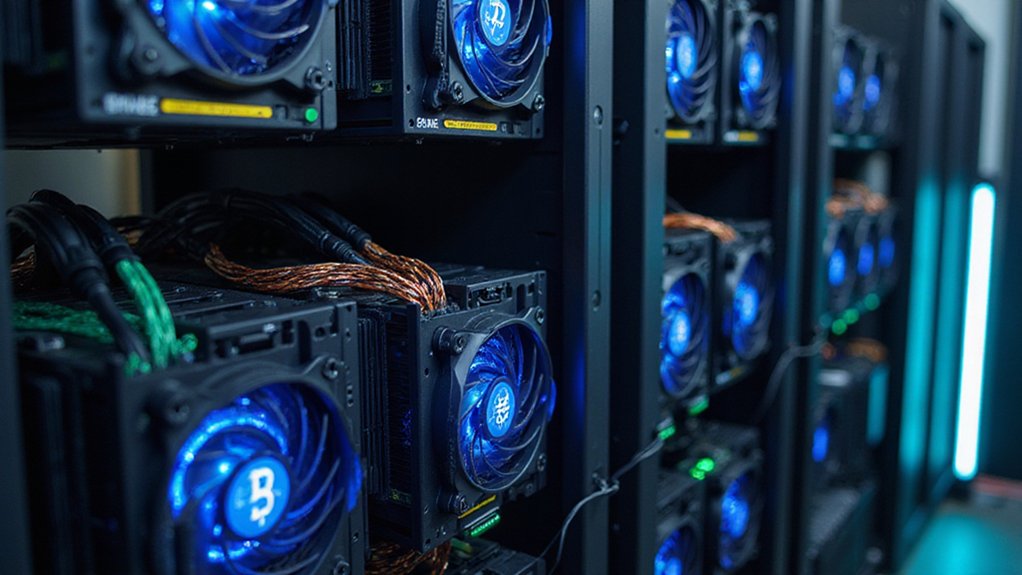
The rapidly evolving landscape of cryptocurrency mining demands an increasingly sophisticated understanding of specialized hardware, particularly as Bitcoin’s difficulty adjustment mechanism continues its relentless upward trajectory.
At the forefront of this technological arms race stand ASIC (Application-Specific Integrated Circuit) miners—purpose-built machines that have rendered general-purpose computing hardware obsolete in the pursuit of solving cryptographic puzzles for block rewards.
When evaluating mining equipment, two metrics reign supreme: hashrate and energy efficiency.
In the realm of mining economics, hashrate and energy efficiency stand as the twin pillars of profitability assessment.
The former, measured in terahashes per second (TH/s), quantifies a miner’s computational output, while the latter, expressed in joules per terahash (J/TH), determines operational sustainability in an industry where electricity costs can devour profits with startling efficiency.
The 2025 market presents several significant contenders, including Bitmain’s Antminer S21 Pro (234 TH/s at 15 J/TH) and MicroBT’s Whatsminer M66S (boasting a formidable 298 TH/s, albeit at a less efficient 18 J/TH).
Initial acquisition costs represent merely the opening gambit in a complex financial equation.
One must factor in ongoing electricity expenses (a perpetual drain on profitability), cooling requirements (lest one’s investment transform into an extraordinarily expensive space heater), and depreciation (accelerated by the relentless march of technological innovation).
Location, too, plays a critical role—regions with subsidized electricity rates often become de facto mining havens.
Setting up mining hardware necessitates attention to several critical components: appropriate power supply units matched to consumption requirements, robust network connectivity, adequate cooling systems, and a properly configured Bitcoin wallet. The advent of liquid and immersion cooling systems has significantly extended hardware lifespans while reducing operational downtime for serious miners.
Many newcomers opt to join mining pools rather than solo mine, aggregating computational resources with other participants to increase the probability of solving blocks and securing more consistent—if smaller—rewards. Before mining begins, users must install specialized mining software applications such as CGMiner or EasyMiner to connect their hardware to their chosen pool.
The judicious selection of mining hardware ultimately hinges on balancing performance metrics against operational costs while considering one’s risk tolerance and investment horizon.
What appears profitable today may become financially untenable tomorrow—a sobering reality in the volatile intersection of cutting-edge technology and speculative finance.
Frequently Asked Questions
How Much Electricity Does a Bitcoin Mining Rig Consume?
Bitcoin mining rigs typically consume between 1,200 and 3,500 watts per unit during continuous 24/7 operation—a staggering energy appetite that would make even the most power-hungry household appliances blush.
This consumption varies considerably based on hardware efficiency (with modern ASICs outperforming their predecessors), cooling requirements, and geographic location.
While manufacturers relentlessly pursue efficiency improvements per terahash, these devices remain extraordinarily electricity-intensive compared to conventional computing equipment.
Can I Mine Bitcoin With My Gaming PC?
While technically possible, mining Bitcoin with a gaming PC represents a journey into financial masochism.
Gaming GPUs—optimized for rendering graphics rather than SHA-256 calculations—operate at a spectacular disadvantage against purpose-built ASIC miners, which perform orders of magnitude more efficiently.
The economics prove particularly grim: electricity costs typically exceed potential earnings, and hardware degradation accelerates under continuous mining loads.
For the financially prudent, alternatives like mining altcoins or joining pools present marginally less impractical options.
Is Bitcoin Mining Hardware Noisy?
Yes, bitcoin mining hardware is notoriously noisy.
Most ASIC miners generate between 70-90 decibels—comparable to standing next to a vacuum cleaner continuously.
The cacophony stems primarily from cooling systems desperately trying to prevent the overheating of machines running complex calculations around the clock.
While noise-reduction solutions exist (quieter fans, immersion cooling, optimized fan speeds), they typically require additional investment or sacrifice some mining efficiency.
Community complaints have, unsurprisingly, become increasingly common where mining operations cluster near residential areas.
How Long Does Mining Hardware Typically Last Before Becoming Obsolete?
Mining hardware typically lasts 3-5 years physically but becomes economically obsolete much faster—often within 1-2 years.
This accelerated obsolescence stems from the relentless march of competing technologies (newer ASICs rendering yesterday’s marvels into tomorrow’s paperweights) and Bitcoin’s difficulty adjustments, which continually raise the efficiency bar.
Quality manufacturers like Bitmain produce more durable equipment, but even their premium offerings succumb to the brutal economics of an industry where profitability evaporates faster than datacenter cooling fluid.
What Happens to Mining Profitability After Bitcoin Halving Events?
Bitcoin halvings trigger a profitability squeeze as block rewards—miners’ primary revenue source—are cut by 50%.
This economic shock ripples through the mining ecosystem, forcing less efficient operators into extinction while the survivors adapt through hardware upgrades, energy optimization, or consolidation.
Post-halving, difficulty adjustments typically rebalance the playing field somewhat, while miners increasingly rely on transaction fees.
Historically, price appreciation has eventually offset reward reductions (though one might question the sustainability of this pattern indefinitely).
